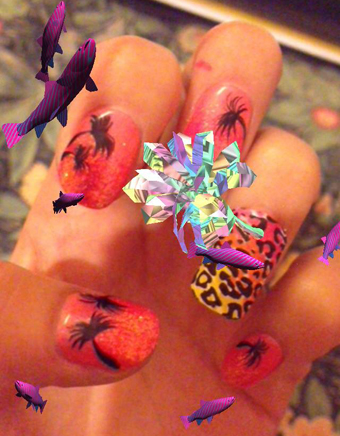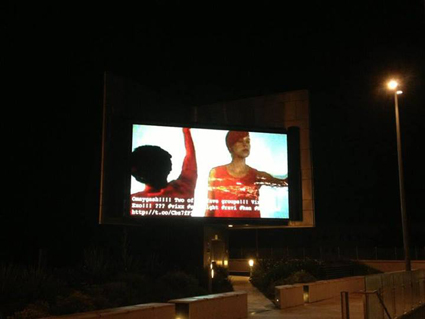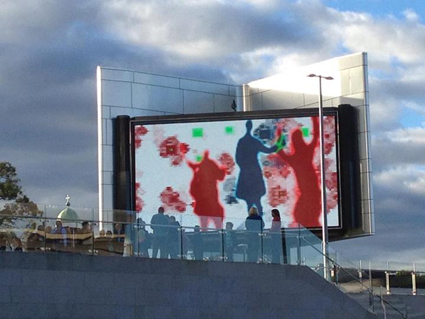Nailing the virtual
Virginia Baxter, Keith Gallasch, The Portals

Thea Baumann, Ben Ferns, Shian Law , Metaverse Makeovers
courtesy the artists
Thea Baumann, Ben Ferns, Shian Law , Metaverse Makeovers
Metaverse Makeovers
On the precinct skirting the outdoor urban screen at The Concourse in suburban Chatswood, the Portals project has set up a virtual nail salon. Two young local manicurists are on hand to paint our fingernails and to install the special accessory that will allow us entrée to the Metaverse.
Seated on a couch, we glimpse some possibilities of our augmented reality status as another of the team waves his iPad over our nails to demonstrate their new capabilities: suddenly fish swim from our fingertips, flowers unfold, glowing baubles explode in coloured flashes. Move a finger slowly and a shiny ball will follow. It’s decidedly blingy, but fun.
Thea Baumann, Ben Ferns and Shian Law are the creative team behind Metaverse Makeovers. Splitting her time between Australia, Tokyo and Shanghai, Baumann is onsite at Chatswood searching on her iPad for Law who’s in Darwin with Lia Tabrah, the fashion designer responsible for the fetching Hologram Hostess outfit worn by Law. The costumes around as at The Concourse are a riotous blend of kaleidoscopic patterns in pink and yellow lycra, worn with platinum or pink wigs. Telematic communication flows wildly in this little corner of an otherwise formal plaza. While a line of high school musicians files into the theatre, Annette Shun Wah’s live interview with Baumann is followed by a blast from Darwin where the team appears to be wrestling a green plastic crocodile. Meanwhile, a pop up reminds us that Julian Assange will address the ISEA multitudes tonight and Creative Producer Ricardo Peach is running us through the other four Portals projects featured this week at the Concourse on his app-packed smart phone.
Through The Portals with Ricardo Peach:
Distributed Empire
Peach explains that “Distributed Empire [Justin Clemens, Christopher Dodds & Andrew Nash] is a kind of portraiture work where people upload photographs of themselves or their heroes to an app that sends the image into the Distributed Empire network that sources similar faces, morphing yours with others into a new portrait that evolves over time.
“Adam told me that for the four-day event the algorithms themselves will decide what the aesthetic will be for this mass portrait in the end. It’s sonified with a composition that Adam made for it. But he’s also developing an algorithm that will use the data from your face to generate a ‘sound sculpture.’
“The face has changed so much over the last few days. It started off quite realistic and then has become quite abstract. I think it’s become quite cubist at the moment.
“You load yourself up, see yourself appear on the big screen and then you morph with other faces. When you go to distributedempire.net you’ll also be able to see other people’s faces who have uploaded themselves onto this sonic, visual sculpture. You can see people taking pictures of themselves here in Darwin and in Sydney…anywhere really.
“Adam’s also been uploading famous portraits as well, the Mona Lisa, the Madonna, also pop culture idols. Technically this work can evolve over years.”
Is Starlight a Wifi Signal?

Nancy Mauro-Flude, Nick Smithies, Crystal Thomas, Is Starlight a Wifi Signal?
courtesy the artists
Nancy Mauro-Flude, Nick Smithies, Crystal Thomas, Is Starlight a Wifi Signal?
Peach tells us about Is Starlight a Wifi Signal? [Nancy Mauro-Flude, TAS; Nick Smithies, TAS; Crystal Thomas and Frontline Media, NT], a telematic performance between Hobart, Darwin and Sydney. “Nancy was in Hobart creating gestural movements with Crystal in Darwin. It’s a slow piece with a series of images and texts that evolve with [the artists] co-ordinating and working across a network to see how they react to each other while reconfiguring images and messages, including tweets to the stars from the audience via the hashtag #starlight. People in Darwin experienced it very differently from people in Sydney and Hobart.
“Nancy is questioning how we can negotiate with each other now that we ubiquitously work across networks. What does it mean for us in our personal relations and how we see each other? The work is a complex philosophical piece, very beautifully done. Quite poetic. I’ve uploaded a longer version on Facebook.”
Mauro-Flude writes in the catalogue, “We have always navigated by the stars, and now as a species, we regularly and increasingly, habitually use networked communication systems (GSM, Bluetooth, Wifi, RFID, QR, AR, radio). These omnipresent transmissions and signals are a new kind of fictional species that exist with/in us. What is happening on the level of the machine now information technologies are building new habitats, cosmographies and cosmologies?”
Shadow Net

Jimmy McGilchrist, Matt Ditton, Tom Killen, Tyler Solleder and Johan Dreyer, Shadow Net
courtesy the artists
Jimmy McGilchrist, Matt Ditton, Tom Killen, Tyler Solleder and Johan Dreyer, Shadow Net
Peach shows us video of intersecting, moving shadows, generated by people passing by a camera or by consciously performing in front of it. Some are in Sydney, some in Darwin but all are on the big screens in both cities. “In Shadow Net by Jimmy McGilchrist (SA, NSW) and Matt Ditton (VIC), people dancing on a green mat in front of X-Box Connects in separate locations appear as shadows onscreen, one blue, one red. They can see each other’s movement. Where their shadows overlap the colours turn green, creating icons [elsewhere on the screen] which when activated by movement generate sound, creating a sonic environment. There’s more of rumba sound if you hit the bottom squares.
“[The participants] look at the big screen and they don’t see the difference between themselves and their shadow. They communicate gesturally and also sonically.”
The artists write on Facebook: “Through these shadows, strangers across vast distances are asked to create their own, virtual relationships, and to contemplate the impact of anonymity and intimacy in our ever expanding, highly networked world.”
Enquire Within Upon Everybody
“In writer Chris Rodley and hybrid media artist Andrew Burrell’s Enquire Within Upon Everybody,” says Peach, “you tweet #enquire Sydney or #enquire Darwin and then your tweets appear at the top of the screen, scrolling. Overnight, the artists work to develop a narrative from questions from the day before; that then appear on the right hand side of the screen. Questions appear like, ‘What is the meaning of life?’ The work automatically searches for all the things that are happening on Twitter at that moment. It recognises similar words and comes back to you with an answer. Obviously people tweet about their religion a lot—so God featured very heavily today. We had a lot of ‘God bless you, you’ll be fine” answers. One of the questions that came up was ‘Is marriage [only] between a man and a woman?’ And the answer that came back very clearly was ‘Yes, definitely.’ As Andrew said, ‘It may not be the answer you want to hear but it’s the answer that seems to be out there in the universe.’”
As The Portals catalogue puts it, Burrell and Rodley are “exploring the poetics of search: the creative possibilities of filtering and recombining online data through search queries…inciting questions about the un/reliability of digital information and the im/possibility of uniqueness in networked environments, where almost everything we want to say is always, already being said by someone else.”
Kinds of connectedness
From what we saw of and heard about The Portals [see also Somaya Langley’s response], it’s clear that its works are very much about realising the expressive power of shared play—with images, sound, data flow and live performance—that can come with experimentation with digital networks across vast distances. This is art-making which doubles as social engagement for participants professional and amateur, and passersby, beyond the limits of conventional discourse.






